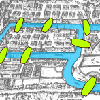creativity
If there has been one overarching theme at this ICM, it's just how creative a subject mathematics is.
In the game of Nim one player always has a winning strategy — it depends on an unusual way of adding numbers.
Asking good questions is an important part of doing maths. But what makes a good question?
Sometimes a piece of maths can be so neat and elegant, it makes you want to shout "eureka!" even if you haven't produced it yourself. One of our favourite examples is the art gallery problem.
Patterns and structures lie at the heart of mathematics, some even say they are mathematics. But how do they help us do mathematics?
What were your most creative experiences at school? Art? Music? English? Maths? That last one might not be the obvious choice for many of us, but that is exactly the type of opportunity we are hoping to create in a new project. To help us get started, we asked researchers what role creativity has in their work.
At last month's Cambridge Science Festival we had great fun trying out a hands-on (or rather feet-on) activity based on one of our favourite puzzles – the bridges of Königsberg. We were really pleased with how it went, so we thought we'd share our game for others to put on at their own science or maths event.
Can we always find order in systems that are disordered? If so, just how large does a system have to be to contain a certain amount of order?
A Gömböc is a strange thing. It wriggles and rolls around with an apparent will of its own. Until quite recently, no-one knew whether Gömböcs even existed. Even now, Gábor Domokos, one of their discoverers, reckons that in some sense they barely exists at all.
We've read the book. We've bought the T-shirt. And now, finally, here it is: the movie of one of our favourite maths problems
How to make a hard problem easy by changing the way you look at it.


